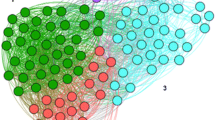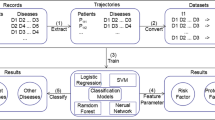Abstract
Objective
To obtain the subtypes of the clinical hypertension population based on symptoms and to explore the relationship between hypertension and comorbidities.
Methods
The data set was collected from the Chinese medicine (CM) electronic medical records of 33,458 hypertension inpatients in the Affiliated Hospital of Shandong University of Traditional Chinese Medicine between July 2014 and May 2017. Then, a hypertension disease comorbidity network (HDCN) was built to investigate the complicated associations between hypertension and their comorbidities. Moreover, a hypertension patient similarity network (HPSN) was constructed with patients’ shared symptoms, and 7 main hypertension patient subgroups were identified from HPSN with a community detection method to exhibit the characteristics of clinical phenotypes and molecular mechanisms. In addition, the significant symptoms, diseases, CM syndromes and pathways of each main patient subgroup were obtained by enrichment analysis.
Results
The significant symptoms and diseases of these patient subgroups were associated with different damaged target organs of hypertension. Additionally, the specific phenotypic features (symptoms, diseases, and CM syndromes) were consistent with specific molecular features (pathways) in the same patient subgroup.
Conclusion
The utility and comprehensiveness of disease classification based on community detection of patient networks using shared CM symptom phenotypes showed the importance of hypertension patient subgroups.
Similar content being viewed by others
References
Forouzanfar MH, Afshin A, Alexander LT, Anderson HR, Bachman VF, Biryukov S, et al. Global, regional, and national comparative risk assessment of 79 behavioural, environmental and occupational, and metabolic risks or clusters of risks, 1990–2015: a systematic analysis for the Global Burden of Disease Study 2015. Lancet 2016;388:1659–1724.
Liu LS. 2010 Chinese guidelines for the management of hypertension. Chin J Cardiol (Chin) 2011;39:579–615.
Oparil S, Acelajado MC, Bakris GL, Berlowitz DR, Cífková R, Dominiczak AF, et al. Hypertension. Nat Rev Dis Primers 2018;4:18014.
Ashley EA. Towards precision medicine. Nat Rev Genet 2016;17:507–522.
Li L, Cheng WY, Glicksberg BS, Gottesman O, Tamler R, Chen R, et al. Identification of type 2 diabetes subgroups through topological analysis of patient similarity. Sci Transl Med 2015;7:311ra174.
Dienstmann R, Vermeulen L, Guinney J, Kopetz S, Tejpar S, Tabernero J. et al. Consensus molecular subtypes and the evolution of precision medicine in colorectal cancer. Nat Rev Cancer 2017;17:79–92.
Franklin SS, ed. Hypertension. 2nd ed. Philadelphia: WB Saunders; 2005:230–236.
Fouad FM, Tarazi RC, Gallagher JH, MacIntyre WJ, Cook SA. Abnormal left ventricular relaxation in hypertensive patients. Clin Sci 1980;59(s6):411s–414s.
Smulyan H, Safar ME. Systolic blood pressure revisited. J Am Coll Cardiol 1997;29:1407–1413.
Franklin SS, Pio JR, Wong ND, Larson MG, Leip EP, Vasan RS, et al. Predictors of new-onset diastolic and systolic hypertension: the Framingham Heart Study. Circulation 2005;111:1121–1127.
Choi SW, Kim MK, Han SW, Kim SH, Kim HJ, Kang SM, et al. Characteristics of hypertension subtypes and treatment outcome among elderly Korean hypertensives. J Am Soc Hypertens 2014;8:246–253.
Luo N, Craig DM, Ilkayeva O, Bain J, Muehlbauer M, Kraus WE, et al. Plasma Metabolomic profiles differentiate haemodynamic subtypes of pulmonary hypertension. Circulation 2015;132(Suppl 3):A16622.
Zhang AH, Sun H, Wang P, Han Y, Wang X. Future perspectives of personalized medicine in traditional Chinese medicine: a systems biology approach. Complement Ther Med 2012;20:93–99.
Jiang M, Lu C, Zhang C, Yang J, Tan Y, Lu A, et al. Syndrome differentiation in modern research of traditional Chinese medicine. J Ethnopharmacol 2012;140:634–642.
Shu ZX, Liu WW, Wu HK, Xiao M, Wu D, Cao T, et al. Symptom-based network classification identifies distinct clinical subgroups of liver diseases with common molecular pathways. Comput Meth Prog Bio 2019;174:41–50.
Chen YB, Pan XQ, Jin LS, ed. Classification and codes of diseases and syndrome of traditional Chinese medicine. Beijing: Standards Press of China; 1995.
Rappaport N, Twik M, Plaschkes I, Nudel R, Iny Stein T, Levitt J, et al. MalaCards: an amalgamated human disease compendium with diverse clinical and genetic annotation and structured search. Nucleic Acids Res 2017;45(D1):D877–D887.
Park J, Lee DS, Christakis NA, Barabási AL. The impact of cellular networks on disease comorbidity. Mol Syst Biol 2009;5:262.
McHugh ML. The chi-square test of independence. Biochem Med 2013;23:143–149.
Yang J, Leskovec J. Overlapping community detection at scale: a nonnegative matrix factorization approach. In: Proceedings of the sixth ACM international conference on Web search and data mining. New York: ACM; 2013:587–596.
Blondel VD, Guillaume JL, Lambiotte R, Lefebvre E. Fast unfolding of communities in large networks. J Stat Mech 2008;2008:P10008.
Šubelj L, van Eck NJ, Waltman L. Clustering scientific publications based on citation relations: a systematic comparison of different methods. PLoS One 2016;11:e0154404.
Miettinen OS. Components of the crude risk ratio. Am J Epidemiol 1972;96:168–172.
Jiao X, Sherman BT, Huang DW, Stephens R, Baseler MW, Lane HC, et al. DAVID-WS: a stateful web service to facilitate gene/protein list analysis. Bioinformatics 2012;28:1805–1806.
Kotchen TA, Cowley AW, Liang MY. Ushering hypertension into a new era of precision medicine. J Am Med Assoc 2016;315:343–344.
Cohuet G, Struijkerboudier H. Mechanisms of target organ damage caused by hypertension: therapeutic potential. Pharmacol Therapeut 2006;111:81–98.
Li W, Jiang YH, Wang Y, Zhao M, Hou GJ, Hu HZ, et al. Protective effects of combination of Radix Astragali and Radix Salviae Miltiorrhizae on kidney of spontaneously hypertensive rats and renal intrinsic cells. Chin J Integr Med 2020;26:46–53.
Zhao JH, Zhang L, Liu Y, Cheng QL. Effect of Shexiang Baoxin Pill in alleviating early hypertensive renal injury in rats. Chin J Integr Med 2021;27:47–53.
Singh RB, Mengi SA, Xu YJ, Arneja AS, Dhalla NS. Pathogenesis of atherosclerosis: a multifactorial process. Exp Clin Cardiol 2002;7:40–53.
Feldmann M, Brennan FM, Maini RN. Role of cytokines in rheumatoid arthritis. Annu Rev Immunol 1996;14:397–440.
Bomfim GF, Santos RAD, Oliveira MA, Giachini FR, Akamine EH, Tostes RC, et al. Toll-like receptor 4 contributes to blood pressure regulation and vascular contraction in spontaneously hypertensive rats. Clin Sci 2012;122:535–543.
Wang MS, Liu SL, Xu LS, Ming H, Zhou X, Su J. Discussion on syndrome differentiation and treatment based on the relationship between main syndrome, secondary syndrome and combined syndrome in treatise on febrile diseases. J Hubei Univ Tradit Chin Med (Chin) 2018;20:72–74.
Miaskowski C, Barsevick A, Berger A, Casagrande R, Grady PA, Jacobsen P, et al. Advancing symptom science through symptom cluster research: expert panel proceedings and recommendations. J Natl Cancer Inst 2017;109:djw253.
Liu CN, Liu YZ, Deng Y, Li S, Nan Z. Experimental research on “Precision TCM” based on structural partial-ordered attribute diagram. In: 2015 Fifth International Conference on Instrumentation and Measurement, Computer, Communication and Control (IMCCC). Piscataway: IEEE; 2015:1–4.
Zhou XZ, Lei L, Liu J, Halu A, Zhang Y, Li B, et al. A systems approach to refine disease taxonomy by integrating phenotypic and molecular networks. EBioMedicine 2018;31:79–91.
Sun NL, Wang HY, Zhu DL, Liao YH, Lin SG, Chen XP. Association between albuminuria and blood pressure level in patients with essential hypertension. Chin J Nephro (Chin) 2010;26:762–765.
Yang K, Wang N, Liu GM, Wang R, Yu J, Zhang R, et al. Heterogeneous network embedding for identifying symptom candidate genes. J Am Med Inform Assoc 2018;25:1452–1459.
Goldschmidt A. Three case histories on cold damage disorders from Ninety Discussions on Cold Damage Disorders by Xu Shuwei (1080-1154). Asian Med 2013;8:459–471.
Epler DC. The concept of disease in an ancient Chinese medical text, the Discourse on Cold-Damage Disorders (Shang-han Lun). J Hist Med All Sci 1988;43:8–35.
Author information
Authors and Affiliations
Contributions
Li W and Zhou XZ conceived and designed the experiments; Peng W, Li YL, Ren YH, Chen C, and Wang HY standardized the terms of symptoms and diagnoses; Wang YF and Wang JJ performed the experiments; Huan JM, Gao C, Wang R, Wang XF, Han SJ, Lyu JY, and Shu ZX analysed the data; Wang JJ wrote the manuscript; Zhou XZ and Li W revised the manuscript. All authors read and approved the final manuscript.
Corresponding author
Ethics declarations
The authors declare that the research was conducted in the absence of any commercial and financial relationships that could be construed as a potential conflict of interest.
Additional information
Supported by the National Key Research and Development Project of China (No. 2017YFC1703502 and No. 2017YFC1703506)
Electronic supplementary material
Rights and permissions
About this article
Cite this article
Wang, Yf., Wang, Jj., Peng, W. et al. Identification of Hypertension Subgroups through Topological Analysis of Symptom-Based Patient Similarity. Chin. J. Integr. Med. 27, 656–665 (2021). https://doi.org/10.1007/s11655-021-3336-3
Accepted:
Published:
Issue Date:
DOI: https://doi.org/10.1007/s11655-021-3336-3




